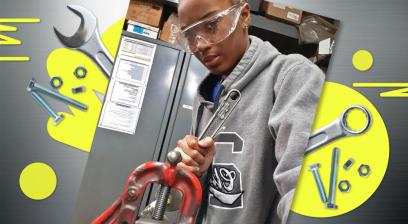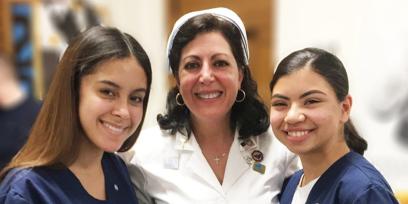In Lynn, Mass., a high school girl wearing safety goggles shapes and solders copper plumbing pipes. A boy in Ft. Lauderdale, Fla., manipulates gear cogs on a computer screen to engineer a competition robot. And in Newark, N.J., a teenager steps into an elementary school classroom—as teacher for the day.
These are just a few of the lives that are being shaped by career and technical education, an approach that combines experiential practice and academics to unlock learning for so many students.
The AFT believes that bringing real-world experiences to all students can engage them and make academic material more relevant. Experiential learning can give young people opportunities to go beyond textbooks, worksheets and lectures and get into the muscle and bone of learning—by doing. For example, in a civics class about local government, students might learn about the legislative process in their city, then imagine their own school as a city, take on the role of “city” council members, and propose “legislation” that has real meaning in their lives—whether it’s more after-school programs, longer recess times or better sidewalks outside their school.
For students who really commit to CTE—taking multiple courses with industry-certified teachers in programs with professional-grade equipment—results can be profound. Instead of analyzing a diagram on a page, they might wrap an actual blood pressure cuff around a classmate’s arm, tugging at the Velcro to adjust it before reading the results. They feel the heft of the industrial drilling machine as they guide its weight toward its target. Or sweat beside the kitchen oven as they try to plate meals for visiting administrators in time for lunch.
In school and on the job
CTE is a powerful motivator: It engages students who might otherwise give up on school, dropping out in the face of academic courses they have trouble connecting to their own lives. Linda Romano nearly flunked out of high school, but enrolling in a CTE nursing program saved her. “The program was relevant to my life, and I felt I had a purpose,” she says in an AFT Voices post. Decades later, she teaches nursing to students like her.
The average graduation rate for students who concentrate on CTE during high school is 94 percent, compared with overall graduation rates of 85 percent, according to the Association for Career and Technical Education (ACTE). And students who concentrate in CTE are more likely to pursue postsecondary education than students who do not. They can even give themselves a boost toward a college degree by using dual-enrollment programs.
Work-based learning—that is, internships and apprenticeships in actual workplaces, often with pay as well as credit toward a high school diploma or a more advanced degree—is another powerful incentive. “These type of programs actually help keep kids in school, because a lot of kids do have to work,” says Casandra D. Robinson, principal at Dillard High School in Fort Lauderdale, Fla., where Broward Teachers Union members work. “I mean, it’s real.”
Students who have earned two or more credits in a CTE pathway are also more likely to be employed full time eight years after graduation.
“We are putting them into jobs with no college debt, right out of high school, [where] they can make an outstanding wage,” says Chuck Byers, credentialing and employability coordinator for New Lexington, Ohio, schools, where programs range from agriculture and environmental science to hydraulics, basic HVAC, business modeling and entrepreneurship.
Students there are caring for pigs and chickens, testing soil, growing grapes and making jelly alongside Future Farmers of America. Kids as young as third grade are learning how to weld. “You see how excited they are about it,” says John Lindsey, a vocational agriculture teacher and a member of the New Lexington Federation of Teachers, looking around at young students entirely immersed in the world of welding. “This is why we’re doing what we’re doing.”
“We believe that if we touch workforce development early and often, [students] will be prepared as they grow,” says Casey Coffey, New Lexington Schools superintendent, who works closely with the union.
Preparing a community workforce
CTE is also beneficial for communities, where businesses can work directly with schools to help train their future workforce. ACTE projects a 6.5 million deficit of skilled workers in the U.S. over the next 10 years, in fields such as healthcare, manufacturing, operations and logistics, information technology and education.
CTE programs can help fill that gap. “We teach everything from conventional machining to CNC programming and CAD/CAM design,” says John Battista, a Chicago Teachers Union member who teaches modern machine technology at Prosser Career Academy in Chicago. “There’s a big need for these kids to be able to do this, to replace my generation’s machinists.”
Superintendent Coffey says he’d like to walk into businesses all through town and see kids from the Lexington Park program, staying in the community and becoming local leaders.
Even if students are not trained directly, they will pick up skills they can use for a life of work in any job. There is a lesson in confidence, when a student accomplishes a concrete task with a product to show for it; there is a lesson in trying and failing, and trying again. There is the feeling of approaching adulthood as a capable, prepared individual.
“It’s not just learning how to work on cars and how to become more mechanically inclined,” says Thomas Murphy, an automotive student at Prosser Career Academy in Chicago. “You’re learning how to work, how to be an adult. You’re doing it right now in high school.”
Click here to see videos of AFT members at work in CTE schools. We will also collect examples of how teachers in regular schools are incorporating experiential learning into their everyday classes; here are some lesson plans our members have created already. To see more content, go to our Real Solutions for Kids and Communities page: Experiential learning and CTE are among the top priorities for our campaign.
[Virginia Myers]


